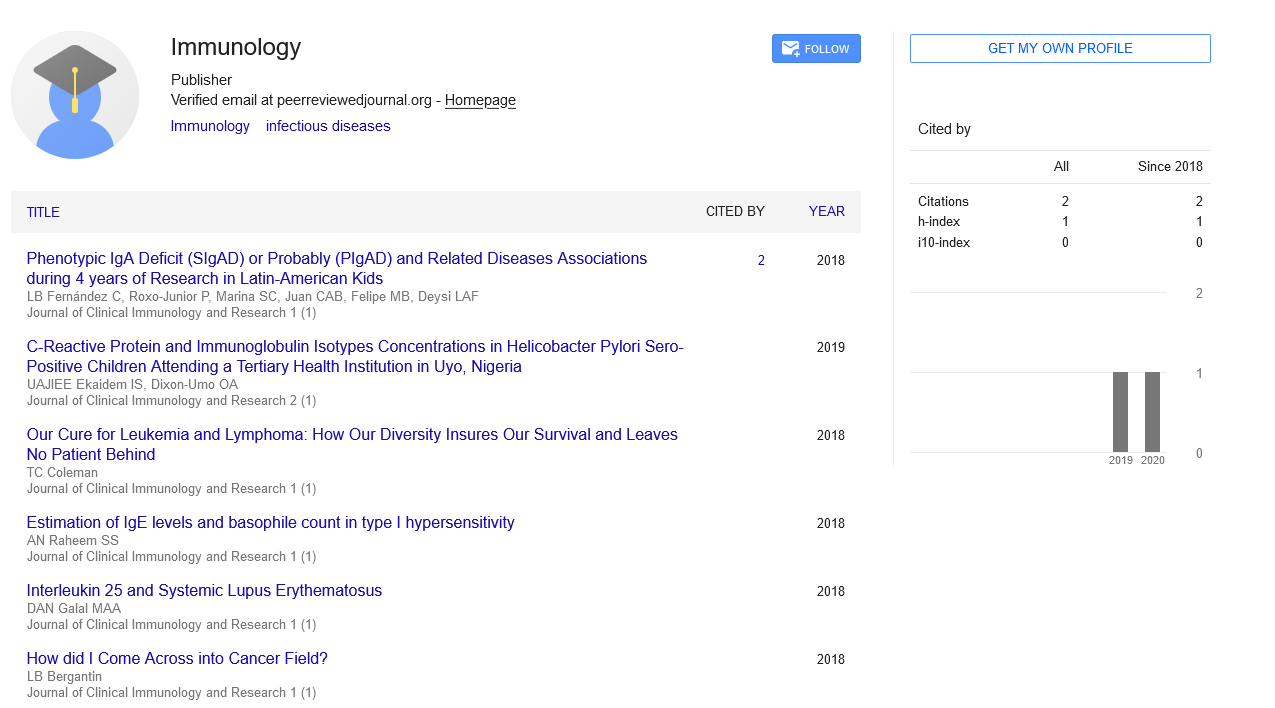Editorial, J Clin Immunol Res Vol: 4 Issue: 3
Inhibitory Descending Projections from Brainstem
Simon Alex *
Department of Oncology, France Metropolitan Geriatric Medical Center, France
*Corresponding author: Simon A, Department of Oncology, France Metropolitan Geriatric Medical Center, Canada; E-mail: Simonal565.com
Received date: June 03, 2021; Accepted date: June 17, 2021; Published date: June 29, 2021
Keywords: Noxious mechanical, thermal
Introduction
Acute pain serves an adaptive purpose to warn the organism of actual or impending tissue injury. Noxious mechanical, thermal, and chemical stimuli activate primary sensory neurons that transmit nociceptive information to the spinal and medullary dorsal horns. Here, peripheral sensory input is integrated in a complex network of secondary nociceptive neurons that project to supraspinal sites, interneurons, and inhibitory descending projections from brainstem sites secondary projection neurons synapse with tertiary neurons in thalamic and parabrachial nuclei that project to cortical and subcortical regions that encode and perceive pain Persistent activation or malfunction of this nociceptive system gives rise to chronic pain. While chronic pain is usually considered to be maladaptive, this idea has recently been challenged. The Neuroimmunology Clinic of the UNIFESP is a public tertiary care center focused on caring for patients with multiple sclerosis and other demyelinating diseases, , and located at Hospital São Paulo, the most general hospital at the UNIFESP complex. Since then, the middle keeps a database containing all clinical, laboratory, radiological and therapeutic information of all the patients attending the clinic. All patients attending the clinic are invited to participate in a prospective registry approved by the university’s institutional review board and sign a written informed consent for clinical and radiological data storage and analysis. This study is a cross-sectional evaluation of this database, encompassing all patients evaluated another mechanism by which the BBB links the immune system and the CNS may also be involved in AD. Immune cell trafficking in AD is poorly explored, but such trafficking is increased with inflammation. Cytokine transporters at the BBB might be altered in AD, thus directly affecting the CNS immune status , or other BBB transporters might be altered, affecting the homeostatic and nutritional roles that the BBB plays for the CNS. Inflammatory events also affect the secretory aspects of the BBB. For example, LPS increases the discharge of cytokines from brain endothelial cells, both from luminal and abluminal membranes [17,18]. This mechanism could lead to increased levels of cytokines in the brain or blood. In conclusion, the BBB is intimately involved in first separating the system from the CNS then regulating their interactions. Many of the regulatory, transporter and secretory functions of the BBB are themselves influenced or suffering from inflammation. Thus, the BBB could affect the AD brain through a wide range of immune-related mechanisms. Evolution has yielded multiple complex and complementary mechanisms to detect environmental danger and protect tissues from damage. The systema nervosum rapidly processes information and coordinates complex defense behaviors, and therefore the system eliminates diverse threats by virtue of mobile, specialized cell populations. The two systems are tightly integrated, cooperating in local and systemic reflexes that restore homeostasis in response to tissue injury and infection. They further share a broad common language of cytokines, growth factors, and neuropeptides that enables bidirectional communication. However, this reciprocal talk permits amplification of maladaptive feed forward inflammatory loops that contribute to the event of allergy, autoimmunity, itch, and pain. Appreciating the immune and nervous systems as a holistic, coordinated defense system provides both new insights into inflammation and exciting opportunities for managing acute and chronic inflammatory diseases. We also reviewed the amount of total appointments also because the number of reports requested (medical reports for job applications, early retirement, benefices for the handicapped, medication usage for international travelers and others) and medications prescriptions renewal demanded by the patients, as these are a part of the “off clinic” regular patient care activities. It is important to say that the Brazilian public healthcare system, requires that all patients present a new medication prescription every three months, in order to maintain regular supply, an important a neighborhood of the “off clinic” described above. Since a complete computerized system for all outpatient activity was only implemented on the second semester of 2013, the clinical activity information was evaluated The intention of this report is to explain the outpatient clinic population, therefore we didn't include appointments made at the emergency department nor clinical, prognostic and treatment response information, available in previous studies from our group. Autoimmune encephalitis is a rare inflammatory disease of the central nervous system which, however, causes significant mortality, and above all morbidity and associated high socioeconomic costs. In recent years, the sector has experienced dynamic development by the pioneering description of synaptic autoantibodies as biomarkers and, altogether likelihood, by disease-causing agents . On the one hand, the discovery of new synaptic antibodies allows a persistent therapeutic and prognostic sub- and reclassification of autoimmune encephalitis syndromes ; on the other hand, the rapid growth of data represents a diagnostic challenge for clinicians and scientists. Due to the rarity of the individual encephalitic syndromes, the more precise characterization of clinical disease.
 Spanish
Spanish  Chinese
Chinese  Russian
Russian  German
German  French
French  Japanese
Japanese  Portuguese
Portuguese  Hindi
Hindi 